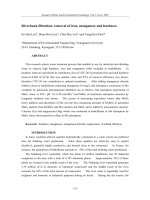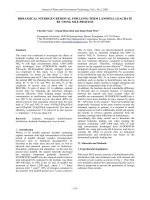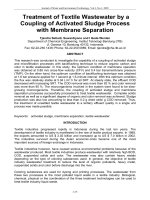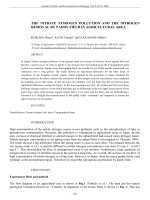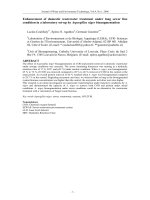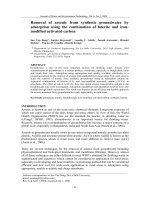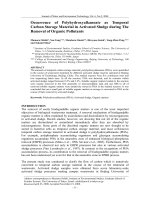Nitrogen removal of aquaculture wastewater
Bạn đang xem bản rút gọn của tài liệu. Xem và tải ngay bản đầy đủ của tài liệu tại đây (289.97 KB, 9 trang )
AACL BIOFLUX
Aquaculture, Aquarium, Conservation & Legislation
International Journal of the Bioflux Society
Nitrogen removal of aquaculture wastewater in
aquaponic recirculation system
1
Sri Wahyuningsih, 2Hefni Effendi, 1Yusli Wardiatno
1
Department of Aquatic Resources Management, Faculty of Fisheries and Marine Science,
Bogor Agricultural University, Bogor, Indonesia; 2 Center for Environmental Research,
Bogor Agricultural University, Bogor, Indonesia. Corresponding author: H. Effendi,
Abstract. Nitrogen wastes in the culture system are still difficult to handle. Aquaponic system can be an
alternative to reduce the impact of the inorganic nitrogen accumulation that can be a limiting factor to
the fish growth. At aquaponic system plant can absorb nutrient from farming waste, whereas bacteria
functions in reducing the ammonia through the nitrification process. The aim of study was to assess
aquaculture nitrogen waste reduction in aquaponic system. The result showed that the nutrient
concentration fluctuated during the observation periods, and the highest nutrients accumulation were
6.489, 3.601, and 0.933 mg L-1 for TAN (ammonia and ammonium), nitrate, and nitrite in the control,
respectively. Integration of tilapia (Oreochromis niloticus) fish farming, romaine lettuce (Lactuca sativa),
and bacteria can reduce inorganic nitrogen with the best removal efficiency. There was 91.50, 34.41,
22.86, and 49.74% for TAN, nitrate, and nitrite, respectively. All results showed that treatment with the
bacteria addition was the best treatment to reduce nitrogen waste, optimizing the fish and romaine
lettuce plants production.
Key Words: ammonia, aquaponic, nitrification, tilapia, romaine lettuce.
Introduction. The main problem in fisheries is water quality degradation caused by the
accumulation culture waste. According to Rakocy et al (2006), fish excretes nitrogenous
waste such as ammonia directly discharged into the aquatic environment. Subsequently,
according Francis-Floyd et al (1996) ammonia becomes the second limiting factor after
oxygen and this parameter gives an effect to the fish growth.
Feed is a major source of ammonia in the culture system (Hargreaves & Tucker
2004), because the fish can only absorb 20-30% of nutrients from the feed, while the
remaining is excreted into the environment in ammonia and organic protein form
(Avnimelech 2006; Hargreaves 1998). According to Ebeling et al (2006), from 80% of
nitrogen excreted, 90% contained as ammonia and 10% as urea.
Total ammonia nitrogen (TAN) in the water consists of ammonia unionized (NH3)
and ammonia ionized (NH4+) (Francis-Floyd et al 1996; Körner et al 2001; Rahmani et al
2004; Eshchar et al 2006; Van Rijn et al 2006; Titiresmi & Sopiah 2006). Temperature
and pH increment will shift the equilibrium of TAN into ammonia which is a more toxic
element. Ammonia toxicity is manifested by hyperactivity, convulsions, loss of
equilibrium, lethargy, and coma (Hargreaves 1998). Chen et al (2006) reported that a
high level of ammonia that can be tolerated in the culture system was 0.025 mg N L-1. In
general, to maintain good water quality, 5-10% volume of water containing nitrogen
should be replaced with fresh water (Masser et al 1999). According to Hu et al (2015)
untreated water containing ammonia discharged into the ecosystem will lead to
eutrophication and other environmental problems.
Aquaponic becomes alternative of nitrogen waste treatment in farming systems,
especially in areas with limited water supply. Aquaponic system is known as a
combination of aquaculture with hydroponic plant in recirculation systems (Diver 2006;
Rakocy et al 2006; Endut et al 2010; Roosta & Hamidpour 2011; Zheljazkov & Horgan
2011; Liang & Chien 2013). Ammonia in aquaponic system is changed into ammonium
AACL Bioflux, 2015, Volume 8, Issue 4.
/>
491
and nitrate (NO3-) by nitrification bacteria (Nitrosomonas sp. and Nitrobacter sp.).
Ammonium and nitrate are absorbed by plants as nutrients (Rakocy et al 2006; Tyson et
al 2011; Liang & Chien 2013). Plants can provide a biofiltration role by absorbing
ammonium, whereas nitrification bacterial provides the dual role of reducing ammonia
concentration through oxidation and converting ammonia to nitrate (Tyson et al 2011).
With this system, water and nutrients can be reused maximally and environmentally
friendly and simultaneously producing two cash corps (Diver 2006; Tyson et al 2011).
This research was intended to assess the nitrogen reduction of aquaculture waste in
recirculating aquaponic system.
Material and Method. This experiment was carried out from February to April 2015 at
Center for Environmental Research of Bogor Agricultural University (PPLH IPB). It
consisted of three treatments, each had three randomly assigned replications. (1) tilapia
(Oreochromis niloticus) without romaine lettuce (Lactuca sativa) as control, (2) tilapia
and romaine lettuce (Lactuca sativa L. var. longifolia) (T1), (3) tilapia, romaine lettuce,
and inoculation with nitrifying bacteria (T2), were assigned.
Nine aquariums (80 x 40 x 40 cm3) with 100 L water volume were chosen as the
fish culture. Reservoir (60 L) and the aquaponic chamber (100 x 15 x 15 cm3) as planting
romaine lettuce were set up. Water from fish cultivation aquarium was drained with the
discharge of 187 L h-1 to the chamber (volume ±1.4 L), passing through the roots of
romaine lettuce. The water then flew from the chamber to the reservoir for being
homogenized. The water was then piped vertically back into the aquarium (Figure 1).
As much as 20 fishes, average weight of 20 g, size ranged from 9 to 10 cm, were
initially cultivated in each aquarium. Fishes were cultured for 35 days, and fed with
commercial food around 3% of body weight with 30% of protein content. Frequency of
feeding was three times a day.
Commercial nitrifying bacteria were added to the system (except control and T1) as
much as 32 mL per week, containing around 106 CFU m L-1 Nitrobacter sp. and
Nitrosomonas sp.
Two week old romaine lettuce seedlings (height 11 cm) were planted in small pots
(diameter 5 cm). In each chamber was planted 5 romaine lettuces with the distance of
20 cm between plants. Only part of the plant roots was touched by the flowing water as
recommended in nutrient film technique (NFT).
Figure 1. The series of experimental installations.
Water quality parameters such as TAN, nitrite (NO2-), nitrate (NO3-), temperature, pH,
dissolved oxygen (DO), turbidity, and alkalinity were recorded during the experimental
AACL Bioflux, 2015, Volume 8, Issue 4.
/>
492
period with an interval of 7 days using the standard methods outlined in APHA (2008).
Bacterial abundance (CFU m L-1) was determined using total plate count (TPC) method.
Growth performance of tilapia and romaine lettuce was also observed. The concentration
of NH3 can be computed from the following equation (Strickland & Parsons 1972):
% un-ionized ammonia = 100/[1 + antilog (pKa – pH)]
Where: pKa - the multiplication factor;
pH - the measured pH of the solutions.
Table 1 is used to find the value of pKa.
Table 1
pKa value based on temperature between 5-30°C
Temperature (°C)
pKa
5
9.90
10
9.73
15
9.56
20
9.40
25
9.24
30
9.09
Percentage reduction using formula proposed Bay Effendi et al (2015):
% Reduction = [(a-b)/a] x 100%
Where: a
b
- control concentration of water quality parameter at time t;
- treatment concentration of water quality parameter at time t.
Data analyses were performed using statistical package for the social sciences
(SPSS) version 15 with an alpha set at 0.05 (significant at P<0.05). If there were
significant differences at significant level 0.05, then Duncan multiple comparison test was
used to compare means in order to identify significant difference between treatments.
Results and Discussion
Water quality parameters. Table 2 shows the average of water quality during the
study in aquaponic system.
Table 2
Water quality parameter observed during experiment
Parameters
Temperature (°C)
pH
DO (mg L-1)
Alkalinity (mg L-1)
Turbidity (NTU)
TAN (mg L-1)
Ammonia (mg L-1)
Ammonium (mg L-1)
Control
29.18±0.23a
7.28±0.21a
5.33±0.53a
20.07±3.25a
17.51±6.78 a
4.12±1.33a
0.14±0.06a
3.97±1.28a
T1
29.63±0.28b
7.11±0.24b
5.20±0.50a
18.80±3.94a
23.02±8.46 a
3.50±0.71a
0.13±0.04a
3.37±0.67a
T2
29.14±0.36a
7.05±0.17b
5.23±0.39a
18.54±1.21a
21.57±10.72 a
3.46±0.92a
0.12±0.05a
3.34±0.89a
Nitrate (mg L-1)
2.24±0.44a
2.10±0.27a
2.18±0.51a
Nitrite (mg L-1)
0.49±0.13a
0.42±0.12a
0.37±0.13a
T1 - tilapia and romaine lettuce; T2 - tilapia, romaine lettuce and inoculation with nitrifying bacteria - different
letters in the same column are significantly different at P<0.05 level.
Turbidity and total alkalinity did not show any significant difference among all treatments.
However, values in control were lower for turbidity and higher for alkalinity. Dissolved
oxygen decreased during the study, but the value was above 5 mg L-1, within acceptable
limits for tilapia (Villarroel et al 2011). Alkalinity and dissolved oxygen were important to
AACL Bioflux, 2015, Volume 8, Issue 4.
/>
493
eliminate ammonia through nitrification process. Alkalinity was needed as a carbon
source in this process. It was estimated that for every g conversion of ammonia into
microbial biomass, it was needed 4.71 g dissolved oxygen and 3.57 g alkalinity (Ebeling
et al 2006). Temperature and pH fluctuated and showed significant differences (P<0.05).
This condition causes a shift in the equilibrium between ammonia and ammonium
(Hargreaves & Kucuk 2001). When the temperature was 22°C, ammonia fractionation of
TAN was 0.46% and 4.4% at pH of 7.0 and 8.0, respectively (Francis-Floyd et al 1996).
The changes of inorganic nitrogen in control, T1, and T2 during the experiment
are shown in Figure 2.
7,000
NH4-N (mg/L)
6,000
5,000
4,000
Control
3,000
T1
2,000
T2
1,000
0,000
0
7
14
21
28
35
Culture period (day)
(a)
(b)
(c)
(d)
Figure 2. The changes from NH3N (a), NH4+N (b), NO3-N (c) and NO2-N (d) in all
treatments.
Nutrient concentrations increased along with the time of cultivation, where the highest
accumulation levels in control were 6.489, 3.601, and 0.933 mg L-1 for TAN, nitrate, and
nitrite, respectively. Effluent concentration generally increased with time (Endut et al
2011). However, towards the end of experiment period, the concentration of nutrients
were gradually reduced (except nitrite), with the same pattern of decline. Different
concentrations of nutrients during the experiment showed no significant difference
(P<0.05). However the overall best value of decrease of nitrogen compound was
indicated at T2. This tendency was also shown by results of Shete et al (2013), where the
value of nitrogen reduction on treatment with aquaponic system showed better results
than the control without aquaponic system. The nutrient concentrations decline in
experiments related to the utilization by plants and bacteria. On aquaponic systems,
plants and bacteria play a role in sewage purification. Nutrient-rich waste functions as
fertilizer for plant growth, whereas nitrification bacteria associated with the roots of
AACL Bioflux, 2015, Volume 8, Issue 4.
/>
494
plants and play an important role in the nutrient cycle (Diver 2006). Hu et al (2015) adds
that most of the nitrification bacteria attach to the plant roots.
According to the scientific literature (El-Shafai et al 2004; Hargreaves & Kucuk
2001; Chen et al 2006) ammonia in this experiment exceeded the safe limits for tilapia.
El-Shafai et al (2004) reported that the concentration of ammonia should be maintained
under 0.1 mg L-1. According to Hargreaves & Kucuk (2001), chronic toxicity level of
ammonia for tilapia ranging from 0.035 to 0.092 mg L-1. Ammonia toxicity hinders the
ability diffusion among cell membranes (Colt 2006). Ammonia and nitrite are toxic to
fish, but relatively harmless for nitrate (Rakocy et al 2006). Nitrite will be dangerous
when part of Cl- uptake was replaced with nitrite (i.e. fish absorbs nitrites at the expense
of chlorides). This is due to nitrite demonstrates a degree of affinity to the Cl- or HCO3ion exchange (Svobodová 2005). The toxicity of nitrate to freshwater fish is very low (96
h LC50s >1000 mg L-1 as N) and may be related to potential osmoregulation problems
(Colt 2006).
Based on the results of the abundance calculation of bacteria, there were
significant differences (P>0.05), where the T2 value was two times higher (106) than the
control and T1 at the end of the experiment (Figure 3). This value was much lower
compared with the results of Hu et al (2015), which reached 108-1012 for aquaponic
system. One of the cause which causing the low number of bacteria in this study was
likely the deliberate disposal of fish excreta out of the aquarium during the study through
siphoning everyday. Liu & Han (2004) reported that the dynamics of bacterial populations
is limited by the availability of nutrients in the system. Decline in organic matter will
further hinder the rate of nitrification, resulting in low conversion and high accumulation
of TAN (Chen et al 2005). It is different delivered by Tyson et al (2008) that the optimal
pH operating system will more affect loss of TAN than nitrification bacteria population.
Figure 3. The abundance of bacteria in the control, T1, and T2.
Percentage of nitrogen reduction. The reduction percentage of nitrogen compared to
the nitrogen in the controls is presented in Table 3. The best reduction percentage at the
end of the experiment was T2 of 91.50%, 34.41%, and 49.74% for TAN, and nitrite,
respectively. This result compares favorably with previous studies conducted by Effendi
et al (2015) on the use of the lettuce in aquaponic system, i.e. 90.1% and 23.3% for
ammonia and nitrate, respectively. The results of Snow & Ghaly (2008) study using
aquatic plants showed that aquatic plants can significantly decrease the nitrogen waste in
aquaculture amounted 55.9 to 76.0%, 34.5 to 54.4%, and 49.6 to 90.6% for ammonium,
nitrate and nitrite, respectively.
AACL Bioflux, 2015, Volume 8, Issue 4.
/>
495
Table 3
Percentage of nitrogen reduction
Percentage reduction (%)
Time (day)
NH4+N
NH3N
NO3-N
NO2-N
T1
T2
T1
T2
T1
T2
T1
T2
7
30.96
24.16
8.62
13.06
-20.71
-34.80
-15.33
2.14
14
37.76
86.23
4.14
31.90
2.90
3.87
4.89
4.66
21
27.60
14.13
19.19
10.51
8.77
4.26
-15.74
-5.78
28
26.45
47.25
29.48
18.47
19.35
10.56
40.17
41.61
35
83.59
91.50
29.36
34.41
22.86
13.58
28.64
49.74
The decline rate of ammonia was much larger than the ammoniums, nitrites, and nitrates
(Table 3). This decrease related to pH fluctuations during the experiment. According to
Van Rijn et al (2006) pH and temperature influence the TAN fractionation, because at pH
7, TAN will form ammonium. At pH>8.75, 30% of TAN will turn out to be relatively toxic
ammonia. The best reduction percentage of nitrogen occurred in T2, where in this
treatment were added nitrifying bacteria. It is known that nitrification bacteria play an
important role in converting ammonia into nitrate. Ammonia is firstly oxidized to nitrite
by ammonia oxidizing bacteria (AOB), and then converted to nitrate by nitrite oxidizing
bacteria (NOB) (Hu et al 2015). Decrease in ammonia level greater than ammonium,
nitrite and nitrate was also associated with the growth rate of AOB, predicted much faster
than the NOB. AOB population will increase faster than NOB when the temperature is
above 25°C (Yamamoto et al 2008). In addition to bacteria, plants also play a crucial role
in the decline of nutrients. Nutrients can be reduced at the lowest level when the number
of plants more (Tyson et al 2008). Overall, the concentration and percentage reduction in
nitrogen were observed lower in aquaponic systems, especially T2. This indicates that
aquaponic system could potentially be a nitrogen waste treatment technologies.
Aquaponic performance. Increase in water quality at aquaponic system might bring
about the performance of cultivated tilapias at treatment better than that of control.
Tilapia highest survival rate was 96.1% at T2, followed by T2 and control were 94.4%
and 89.17%, respectively. The growth of tilapia increased during the observation period.
Final weight reached double from the initial weight. They were 45.89, 47.80, and 48.49 g
for the control, T1, and T2 respectively. Fish survival and growth were influenced by the
level of ammonia concentration, wherein ammonia causes a decrease in the sublethal of
fish growth (Hargreaves 1998). Feed conversion rate were 2.02, 1.70, and 1.60 for the
control, T1 and T2, respectively. Higher feed conversion rate phenomenon at control was
similar with higher ammonia concentration at control than that of T1 and T2. Ammonia
will give an effect on energy utilization suppress growth (Hargreaves & Kucuk 2001).
At the end of the experiment, romaine lettuce fresh weight reached 61.9-57.7 g
for T1 and T2, with average growth rate of 0.39 and 0.37 cm d-1 for both T1 and T2. This
result was better than in the experiments conducted by Effendi et al (2015) i.e. 0.04 cm
d-1, and lower than in experiments conducted by Endut et al (2011) i.e. 1.91 and 1:32
cm d-1 for water spinach and mustard green, respectively. The growth that has been
shown by the romaine lettuce showed the high absorption of nutrients. A high level of
plant uptake showed a high degree of absorption, thus decreasing the concentration of
nutrients in the system (Hu et al 2015).
Conclusions. Plants and bacteria in aquaponic system play an important role in the
processing of nitrogenous wastes. This study showed that the application of the
aquaponic system has significant influence at nitrogen transformation. Nutrient
concentration during the experiment fluctuated, where treatment with the addition of
romaine lettuce and bacteria showed better results than the control, and treatment of
romaine lettuce without the addition of bacteria. Aquaponic system was able to decrease
AACL Bioflux, 2015, Volume 8, Issue 4.
/>
496
the inorganic nitrogen amounted 91.50%, 34.41%, 22.86%, and 49.74% for ammonia
and ammonium, nitrate, and nitrite, respectively. Performance of tilapia and romaine
lettuce production also showed promising results, and can adapt to fluctuating conditions.
All results showed that aquaponic system can be used as alternative for fish cultivation
waste treatment, and subsequently for plant and fish biomass production.
Acknowledgements. The authors would like to thank Center for Environmental
Research, Bogor Agricultural University for supporting this research.
References
APHA [American Public Health Association], 2008 Standard method for the examination
of water and wastewater. Water Pollution Control Federation, Baltimore, Maryland
(US), 1202 pp.
Avnimelech Y., 2006 Bio-filters: The need for a new comprehensive approach.
Aquaculture Engineering 34:172-178.
Chen S., Ling J., Blancheton J. P., 2006 Nitrification kinetics of biofilm as affected by
water quality factors. Aquaculture Engineering 34:179-197.
Chen Y., Yin J., Wang K., 2005 Long-term operation of biofilters for biological removal of
ammonia. Chemosphere 58:1023-1030.
Colt J., 2006 Water quality requirements for reuse systems. Aquaculture Engineering
34:143-156.
Diver S., 2006 Aquaponics-integration of hydroponics with aquaculture. National Center
for Appropriate Technology (NCAT), United States, pp. 1-28.
Ebeling J. M., Timmons M., Bisogni J. J., 2006 Engineering analysis of the stoichiometry
of photoautotrophic, autotrophic, and heterotrophic removal of ammonia–nitrogen
in aquaculture systems. Aquaculture 257:346-358.
Effendi H., Utomo B. A., Darmawangsa G. M., Hanafiah D. A., 2015 Wastewater
treatment of freshwater Crayfish (Cherax quadricarinatus) culture with lettuce
(Lactuca sativa). International Journal of Applied Environmental Sciences 1:409420.
El-Shafai S. A., El-Gohary F. A., Nasr F. A., Steen N. P., Gijzen H. J., 2004 Chronic
ammonia toxicity to duckweed-fed tilapia (Oreochromis niloticus). Aquaculture
232:117-127.
Endut A., Jusoh A., Ali N., Nik W. B. W., Hassan A., 2010 A Study on the optimal
hydraulic loading rate and plant ratios in recirculation aquaponic system.
Bioresource Technology 10:1511-1517.
Endut A., Jusoh A., Ali N., Nik W. B. W., 2011 Nutrient removal from aquaculture
wastewater by vegetable production in aquaponic recirculation system. Desalination
and Water Treatment 32:422-430.
Eshchar M., Lahav O., Mozes N., Peduel A., Ron B., 2006 Intensive fish culture at high
amonium and low pH. Aquaculture 255:301-313.
Francis-Floyd R., Watson C., Petty D., Pourder D. B., 1996 Ammonia in aquatic systems.
University of Florida, Department of Fisheries and Aquatic Science, Florida Coop,
Ext. Serv. FA-16, 4 pp.
Hargreaves J. A., 1998 Nitrogen biogeochemistry of aquaculture ponds. Aquaculture
166:181-212.
Hargreaves J. A., Kucuk S., 2001 Effects of diel un-ionized ammonia fluctuation on
juvenile hybrid striped bass, channel catfish, and blue tilapia. Aquaculture 195:163181.
Hargreaves J. A., Tucker C. S., 2004 Managing ammonia in fish pond. SRAC Publication
No. 4603, 8 pp.
Hu Z., Lee J. W., Chandran K., Kim S., Brotto A. C., Khanal S. K., 2015 Effect of plant
species on nitrogen recovery in aquaponics. Bioresource Technology 188:92-98.
Körner S., Das S. K., Veenstra S., Vermaat J. E., 2001 The effect of pH variation at the
ammonium/ammonia equilibrium in wastewater and its toxicity to Lemna gibba.
Aquatic Botany 71:71–78.
AACL Bioflux, 2015, Volume 8, Issue 4.
/>
497
Liang J. W., Chien Y. H., 2013 Effects of feeding frequency and photoperiod on water
quality and crop production in tilapia-water spinach raft aquaponics system.
International Biodeterioration and Biodegradation 85:693-700.
Liu F., Han W., 2004 Reuse strategy of wastewater in prawn nursery by mikrobial
remediation. Aquaculture 230:281-296.
Masser M. P., Rackocy J., Losordo T. M., 1999 Recirculating aquaculture tank production
systems: management of recirculating systems. Southern Regional Aquaculture
Center (SRAC), United State, 12 pp.
Rahmani A. R., Mahvi A. H., Mesdaghinia A. R., Nasseri S., 2004 Investigation of
ammonia removal from polluted water by clinoptilolite zeolit. International Journal
of Environmental Science and Technology 1(2):125-133.
Rakocy J. E., Masser M. P., Losordo T. M., 2006 Recirculating aquaculture tank production
Systems: aquaponics-integrating fish and plant culture (revision). Southern
Regional Aquaculture Center (SRAC), United State, 16 pp.
Roosta H. R., Hamidpour M., 2011 Effects of foliar application of some macro- and micronutrients on tomato plants in aquaponic and hydropinic systems. Scientia
Horticulturae 129:396-402.
Shete A. P., Verma A. K., Tandel R. S., Prakash C., Tiwari V. K., Hussain T., 2013
Optimization of water circulation period for the culture of goldfish with spinach in
aquaponic system. Journal of Agricultural Science 5(4):26-30.
Snow A. M., Ghaly A. E., 2008 A comparative study of the purification of aquaculture
wastewater using water hyacinth, water lettuce and parrot’s feather. American
Journal of Applied Sciences 5(4):440-453.
Strickland J. D. H., Parsons T. R., 1972 A practical handbook of seawater analysis.
Fisheries Research Board of Canada, Ottawa, Canada, 310 pp.
Svobodová Z., Máchová J., Poleszczuk G., Hůda J., Hamáčková J., Kroupová H., 2005
Nitrite poisoning of fish in aquaculture facilities with water-recirculating systems.
Acta Veterinaria Brno 74:129-137.
Titiresmi, Sopiah N., 2006 [Teknologi biofilter untuk pengolahan limbah amonia]. Jurnal
Teknologi Lingkungan 7(2):173-179. [In Indonesian].
Tyson R. V., Treadwell D. D., Simonne E. H., 2011 Opportunities and challenges to
sustainibality in aquaponic Systems (reviews). HortTechnology 21(1):6-13.
Tyson R. V., Simonne E. H., Treadwell D. D., 2008 Reconciling pH for ammonia
biofiltration and cucumber yield in a recirculating aquaponic system with perlite
biofilters. Hortscience 43(3):719-724.
Van Rijn J., Tal Y., Schreier H. J., 2006 Denitrification in recirculating systems: Theory
and applications. Aquaculture Engineering 34:364-376.
Villarroel M., Alvariño J. M. R., Duran J. M., 2011 Aquaponics: integrating fish feeding
rates and ion waste production for strawberry hydroponics. Spanish Journal of
Agriculture Research 9(2):537-545.
Yamamoto T., Takaki K., Koyama T., Furukawa K., 2008 Long-term stability of partial
nitritation of swine wastewater digester liquor and its subsequent treatment by
anammox. Bioresource Technology 99:6419-6425.
Zheljazkov V. D., Horgan T. E., 2011 Study on shrimp waste water and vermicompost as
a nutrient source for bell Peppers. HortScience 46(11):1493-14
AACL Bioflux, 2015, Volume 8, Issue 4.
/>
498
Received: 26 May 2015. Accepted: 29 June 2015. Published online: 11 July 2015.
Authors:
Sri Wahyuningsih, Bogor Agricultural University (IPB), Faculty of Fisheries and Marine Science, Department of
Aquatic Resources Management, Indonesia, Bogor 16680, Kampus IPB Dramaga, e-mail:
Hefni Effendi, Bogor Agricultural University (IPB), Centre for Environmental Research, Indonesia, Bogor 16680,
Kampus IPB Dramaga, e-mail:
Yusli Wardiatno, Bogor Agricultural University (IPB), Faculty of Fisheries and Marine Science, Department of
Aquatic Resources Management, Indonesia, Bogor 16680, Kampus IPB Dramaga, e-mail:
This is an open-access article distributed under the terms of the Creative Commons Attribution License, which
permits unrestricted use, distribution and reproduction in any medium, provided the original author and source
are credited.
How to cite this article:
Wahyuningsih S., Effendi H., Wardiatno Y., 2015 Nitrogen removal of aquaculture wastewater in aquaponic
recirculation system. AACL Bioflux 8(4):491-499.
AACL Bioflux, 2015, Volume 8, Issue 4.
/>
499

